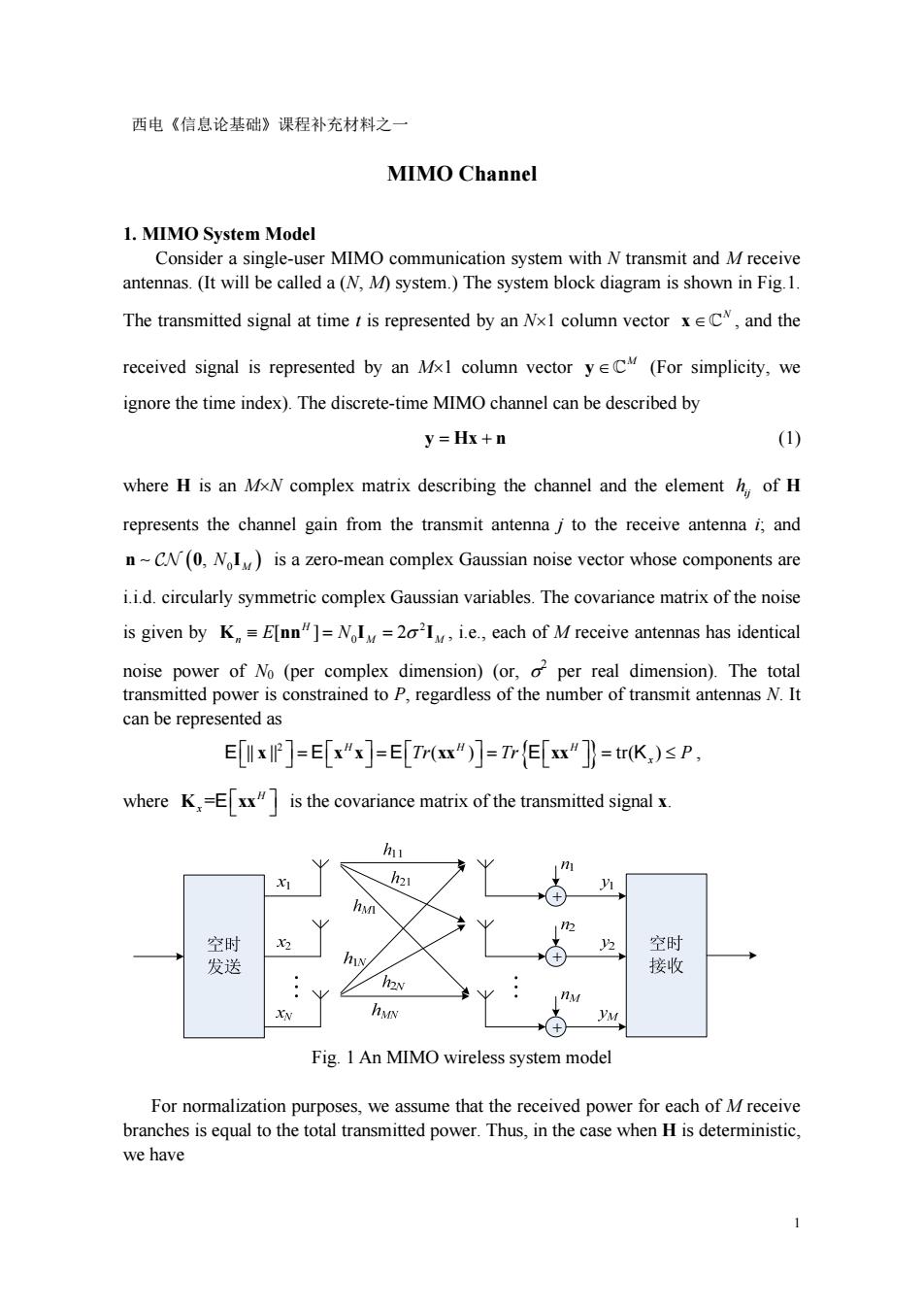正在加载图片...

西电《信息论基础》课程补充材料之 MIMO Channel 1.MIMO System Model Consider a single-user MIMO communication system with N transmit and M receive antennas.(It will be called a(N,M)system.)The system block diagram is shown in Fig.1 The transmitted signal at time tis represented by an Nx1 column vectorxC,and the received signal is represented by an MxI column vector yCM (For simplicity,we ignore the time index).The discrete-time MIMO channel can be described by y=Hx+n (1) where H is an MxN complex matrix describing the channel and the elementh of H represents the channel gain from the transmit antennato the receive antenna i:and n~CN(0,N)is a zero-mean complex Gaussian noise vector whose components are i.id.circularly symmetric complex Gaussian variables.The covariance matrix of the noise is given by KE[nn"]=N=2,i.e.,each of Mreceive antennas has identical plex dimension)(or per real dimension).The total ransmited power constrained toP.regardles of the number of transmit antens N.I com can be represented as ElxIP=E x"x=E Tr(xx")=TrE xx"=tr(K,)sP, where K,=E xx"is the covariance matrix of the transmitted signal x. 、hI 空的 空时 接收 Fig.1An MIMO wireless system model For normalization purposes,we assume that the received power for each of Mreceive branches is equal to the total transmitted power.Thus.in the case when H is deterministic. we have 1 西电《信息论基础》课程补充材料之一 MIMO Channel 1. MIMO System Model Consider a single-user MIMO communication system with N transmit and M receive antennas. (It will be called a (N, M) system.) The system block diagram is shown in Fig.1. The transmitted signal at time t is represented by an N×1 column vector N x ∈C , and the received signal is represented by an M×1 column vector M y ∈C (For simplicity, we ignore the time index). The discrete-time MIMO channel can be described by y = Hx n + (1) where H is an M×N complex matrix describing the channel and the element ij h of H represents the channel gain from the transmit antenna j to the receive antenna i; and ( ) 0 , n 0I ∼ CN N M is a zero-mean complex Gaussian noise vector whose components are i.i.d. circularly symmetric complex Gaussian variables. The covariance matrix of the noise is given by 2 0 [] 2 H K nn I I n MM ≡ == E N σ , i.e., each of M receive antennas has identical noise power of N0 (per complex dimension) (or, σ 2 per real dimension). The total transmitted power is constrained to P, regardless of the number of transmit antennas N. It can be represented as { } 2 || || ( ) tr( ) HHH Tr Tr P x ⎡ ⎤⎡⎤⎡ ⎤ ⎡⎤ = = = =≤ ⎣ ⎦⎣⎦⎣ ⎦ ⎣⎦ E EE E K x x x xx xx , where = H x ⎡ ⎤ K xx ⎣ ⎦ E is the covariance matrix of the transmitted signal x. + + + Fig. 1 An MIMO wireless system model For normalization purposes, we assume that the received power for each of M receive branches is equal to the total transmitted power. Thus, in the case when H is deterministic, we have